Physical Address
304 North Cardinal St.
Dorchester Center, MA 02124
Physical Address
304 North Cardinal St.
Dorchester Center, MA 02124
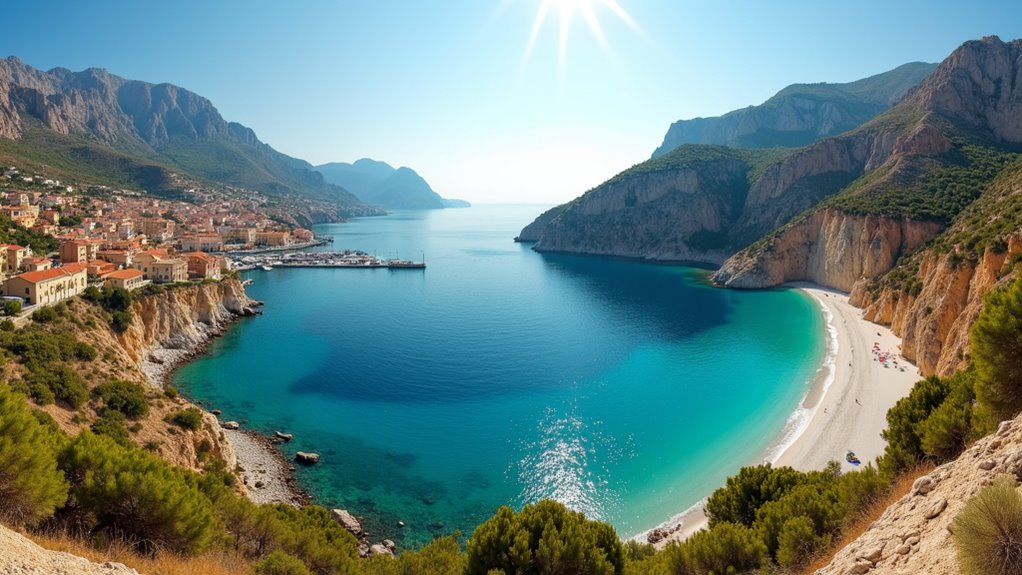
Deciding between Crete's ancient wonders and Kefalonia's unspoiled shores? Discover which Greek paradise truly matches your vacation dreams.
When you’re dreaming of Greek islands, Crete and Kefalonia might both call your name—but they offer distinctly different experiences. You’ll find ancient civilizations and diverse landscapes in Crete, while Kefalonia boasts serene beaches and dramatic coastal scenery. Your perfect island depends entirely on what you’re seeking: historical immersion or natural retreat? Let’s compare these Mediterranean gems across nine essential categories to help you make the choice that matches your ideal vacation vision.
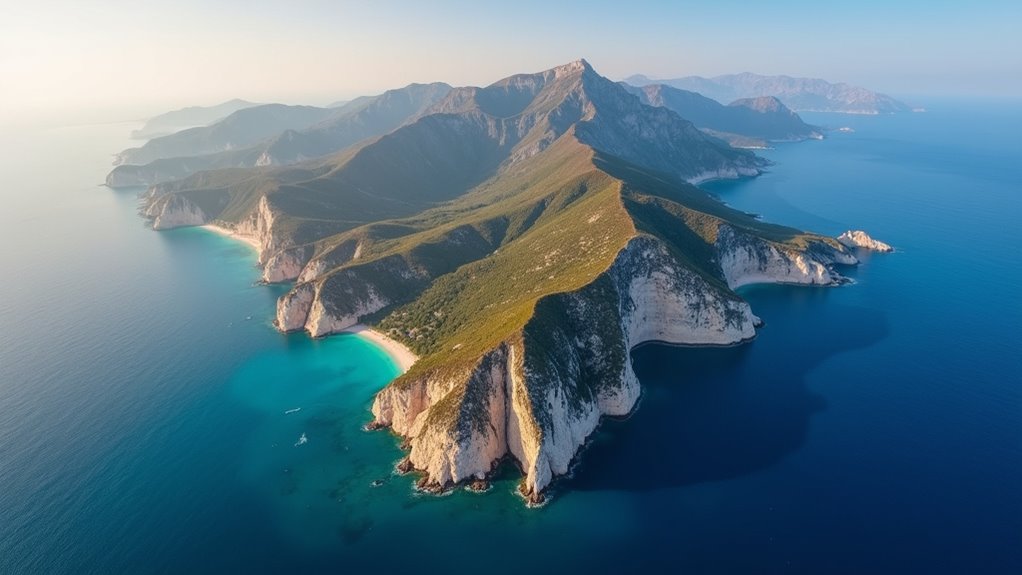
When comparing the Greek islands, size represents one of the most striking differences between Crete and Kefalonia. At 8,300 km², Crete stands as Greece’s largest island, while Kefalonia covers just 842.3 km² as the sixth largest.
You’ll find these islands in completely different seas – Crete bathes in the southern Aegean’s warmer climate, while Kefalonia sits in the Ionian Sea, contributing to its lush landscapes. This geographical separation means distinct regional cultures await you at each destination. Crete is surrounded by numerous islets in both the Aegean and Libyan seas, including notable formations like Spinalonga. Both islands offer romantic getaway spots for honeymooners seeking Mediterranean charm.
Both islands boast impressive mountain ranges, with Crete’s Mount Ida reaching 2,456 meters and Kefalonia’s Mount Ainos standing at 1,628 meters.
Administratively, Crete forms its own region divided into four regional units, whereas Kefalonia is a regional unit within the Ionian Islands administration.
Both islands may share the same country, but their coastlines tell remarkably different stories. Kefalonia specializes in dramatic pebble beaches with turquoise waters—Myrtos and Antisamos being standouts, with the latter famous as Captain Corelli’s Mandolin filming location.
Greece may be one nation, but Kefalonia’s dramatic pebble beaches tell a different story than their mainland cousins.
Crete offers more variety with expansive sandy shores like Elafonissi (featuring rare pink sand) and Balos Lagoon’s shallow waters. The southwest coast between Paleochora and Frangokastello provides visitors with over 320 sunny days annually and significantly less wind exposure than the northern shores. Both islands are consistently ranked among the best islands in Greece for beach enthusiasts and snorkeling adventures.
You’ll find Kefalonia less crowded even in peak season, perfect for secluded exploration via rental boats (€60-65/day).
Crete provides better infrastructure with full-service beach clubs and family-friendly amenities, while Kefalonia requires early arrival (before 11am) at popular spots due to limited parking.
Budget-wise, Kefalonia offers lower prices for sunbeds (€15/day at Myrtos) and affordable tavernas in coastal villages.
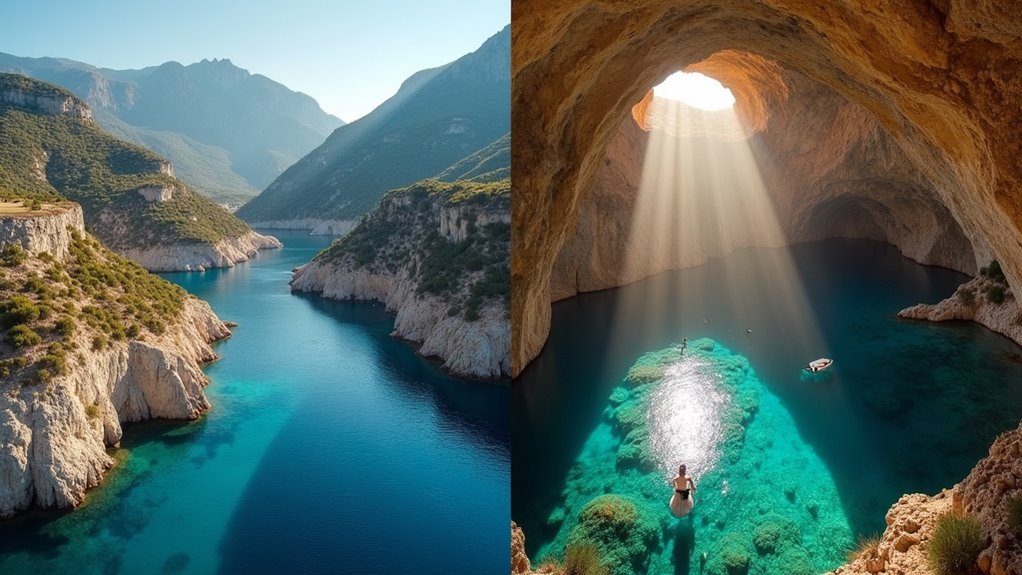
Beyond their inviting beaches, these Greek siblings showcase distinctly different inland treasures worth exploring.
Kefalonia’s crown jewel is Mount Ainos, soaring to 1,628 meters with panoramic island views. You’ll find excellent hiking trails throughout its national park. The island’s underground wonders steal the show—Melissani Cave with its sunlit underground lake and Drogarati Cave with impressive formations.
Crete counters with dramatic gorges like Samaria, offering challenging hikes through spectacular natural beauty. The Lasithi Plateau’s white windmills provide a distinctly different landscape experience. Crete’s impressive mountains such as Lefka Ori range create dramatic backdrops for outdoor adventures. While neighboring Santorini boasts caldera views that attract luxury travelers, Crete offers a more varied and extensive terrain to explore.
While Crete lacks Kefalonia’s famous caves, it compensates with numerous coastal caverns and the sheer diversity of its terrain.
Both islands transform their natural landscapes into economic engines, drawing hikers, explorers, and nature enthusiasts year-round.
Delving into the historical records of these Mediterranean gems reveals vastly different timelines and cultural wealth. Crete boasts Europe’s first advanced civilization with the Minoan Palace of Knossos dating back to 1300 BC, while Kefalonia’s Mycenaean tombs at Tzanata connect it to ancient Ithaca from Homer’s Odyssey.
You’ll experience starkly different preserved histories—Crete maintains its Venetian and Ottoman architecture, whereas Kefalonia’s 1953 earthquake destroyed 90% of its historical structures. Kefalonia’s impressive Cyclopean Walls near Razata, constructed from gigantic rocks and often compared to the Great Wall of China, offer a rare glimpse into ancient defensive engineering. The islands’ cultural expressions differ too: attend Crete’s Easter rocket war or Kefalonia’s August pilgrimage to Agios Gerasimos.
Neither island matches the concentrated historical significance of Athens, where ancient monuments stand as testaments to Western civilization’s birthplace.
Even their UNESCO-recognized culinary traditions contrast—Crete’s Mediterranean diet versus Kefalonia’s robola wine.
For mythology enthusiasts, Crete offers the legendary Minotaur’s labyrinth, while Kefalonia claims connections to Zeus worship on Mount Ainos.
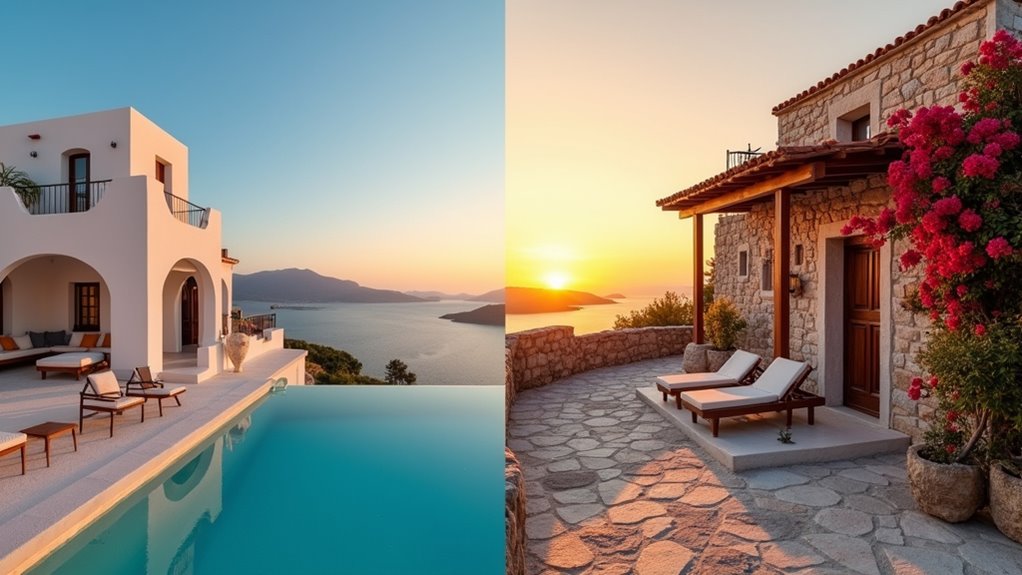
When choosing between Crete and Kefalonia, accommodation options vary considerably in scale, style, and pricing. Crete offers a wider range of hotels with an average nightly cost of €91, while Kefalonia features more boutique and family-run establishments at competitive rates. Both islands provide perfect Greek getaways with distinctive characteristics to suit different traveler preferences.
Selecting between Crete and Kefalonia means choosing between diverse hotel options and intimate family-run establishments, each with distinctive pricing approaches.
For your stay, consider these key differences:
Both islands provide free WiFi and excellent dining experiences, with consistently positive guest reviews.
Although both islands captivate visitors with their beauty, getting to and exploring around Crete and Kefalonia presents distinct challenges and opportunities for travelers.
Getting between these islands isn’t straightforward—there’s no direct ferry connection. Your quickest option is flying via Athens (about 4 hours, €120-280), while the budget-conscious can take bus-ferry combinations (€52-85, taking 21-23 hours). If you’re considering a broader travel experience, island hopping throughout Greece requires careful planning of ferry schedules and connections.
For island exploration, Crete offers superior public transportation with its extensive KTEL bus network connecting major towns hourly. Kefalonia’s limited bus routes mean you’ll face frequency gaps between tourist sites and higher fares (€5-20 versus Crete’s €2-15).
If planning an island-hopping adventure, book at least 2-4 weeks ahead during summer and consider a hybrid approach—flying one way and taking ferries on the return to balance time and cost. For accommodations in Kefalonia, you’ll find over 2,310 hotels starting at €39 per night.
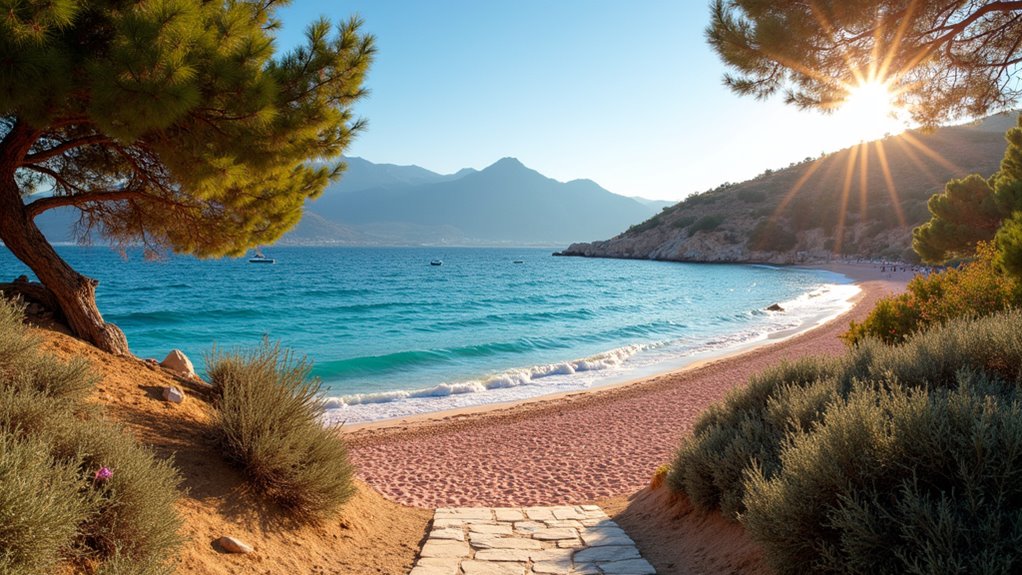
Timing your visit correctly can make or break your Greek island experience, as Crete and Kefalonia each shine during particular seasons. Both islands share similar peak periods, but with subtle differences worth considering.
For exceptional experiences:
Consider planning your vacation during shoulder seasons when you can enjoy budget-friendly options while still experiencing the beauty of these Greek islands.
The culinary landscapes of Crete and Kefalonia offer travelers a feast for the senses that’s just as memorable as their stunning beaches and archaeological sites.
Crete boasts distinctive dishes like dakos (barley rusk topped with tomato and cheese) and kaltsoúnia (sweet cheese pastries), often finishing meals with potent raki. While Crete’s cuisine favors its local cheese varieties over feta cheese, you’ll find hyper-local olive oils, wild mountain herbs, and unique cheeses in their communal meze spreads and slow-cooked meats.
Kefalonia shines with its exceptional local produce, artisanal breads, and casual family-style tavernas featuring fresh seafood. The island’s Robola wine and mandoles (sugared almonds) provide unique tasting opportunities. Both islands embrace the traditional Mediterranean staples like olive oil, seasonal vegetables, and fresh cheeses that define authentic Greek gastronomy.
Both islands embrace Mediterranean staples like olive oil, seasonal vegetables, and fresh cheeses. Though you’ll typically find more dining variety in Crete and slightly lower prices in Kefalonia.
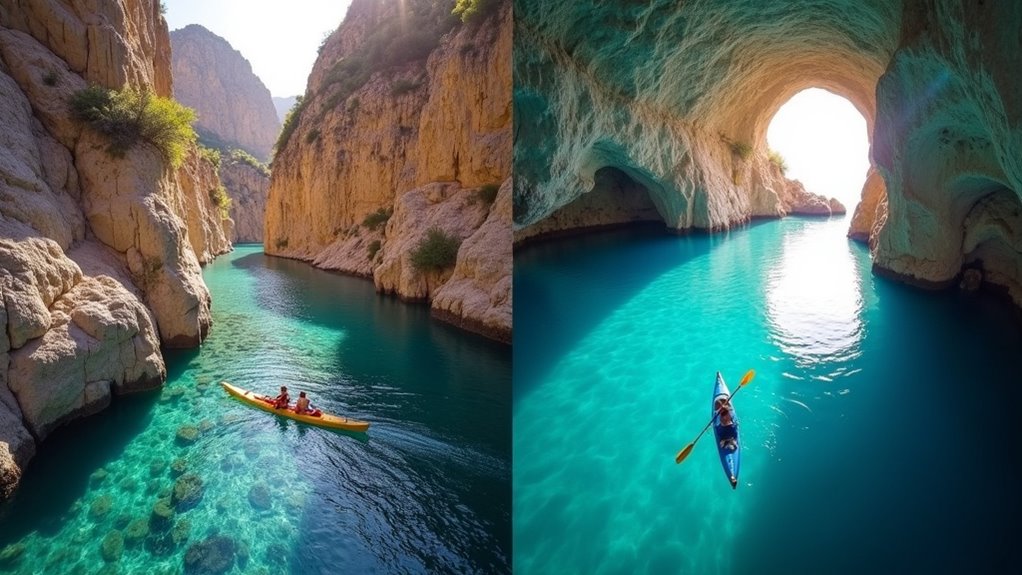
Both islands offer exceptional outdoor adventures, though they cater to different preferences and activity levels. Kefalonia excels with less crowded experiences like Mount Ainos hiking trails and boat rentals to secluded beaches such as Fteri. You’ll find unique underground wonders at Melissani Lake and Drogarati Cave, perfect for exploration away from tourist crowds. Car rental is highly recommended for efficiently accessing these diverse natural attractions across the island. Kefalonia’s Aegean trail network provides some of Greece’s most scenic coastal paths with breathtaking views over turquoise waters.
Crete, meanwhile, boasts more established adventure infrastructure with:
If you’re seeking organized adventure with reliable transportation, Crete delivers. For quieter, self-guided explorations with fewer travelers, Kefalonia might be your ideal match.
While adventure seekers find their paradise in the outdoor activities of both islands, visitors searching for authentic Greek culture will discover vibrant village life beyond the tourist centers.
Beyond tourist hotspots lies the heart of Greece—authentic village life waiting to be discovered by culture-seeking travelers.
On Kefalonia, you’ll experience traditional kantades serenades in Argostoli tavernas and explore Venetian architecture in earthquake-spared Fiscardo. Don’t miss August’s Robola Wine Festival in Fragata or the religious panigiria at Agios Gerasimos Monastery.
Crete offers deeper immersion in rural traditions—from Anogia’s Easter celebrations with midnight lamb roasts to women in Sfakia still baking bread in wood-fired ovens. Families particularly enjoy the island’s fun adventure options ranging from water parks to historical sites that engage visitors of all ages. Visit Rethymno’s old town for stunning Venetian-Ottoman architecture or participate in Vamos cooking classes using hyper-local ingredients. Budget-conscious travelers will appreciate Crete’s more affordable dining options compared to Kefalonia’s higher food costs.
Both islands treasure their afternoon kafenio culture, where locals gather for coffee, backgammon, and spirited conversation.
Your perfect Greek getaway awaits on either island. If you’re craving millennia of history, diverse landscapes, and bustling cultural scenes, Crete will transport you through time. For the most jaw-dropping beaches on earth and peaceful village life, Kefalonia’s your paradise. Consider your vacation priorities—adventure and exploration or relaxation and natural beauty—then pack your bags. You can’t make a wrong choice between these Mediterranean gems.